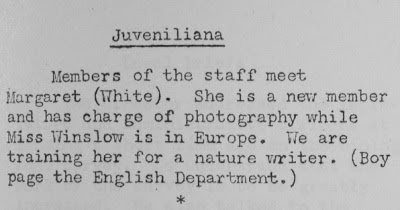I was looking through some ancient back issues of "The Ark" for some information about a particular expedition. The Ark was a newsletter published by the UM Museum of Zoology back in the 1920s. It's filled with a lot of interesting information about the museum before and shortly after it moved to its present location in 1928. However, I stopped at one page from the March 1923 issue and realized that I had just read an unremarkable statement about a most remarkable photographer.
.JPG)
The Margaret (White) shown here is none other than the woman who would later be known as Margaret Bourke-White, one of the great photographers of the 20th century. Of course, nobody at the Museum would have known that the young woman working in the darkroom would become an extraordinary photojournalist, with iconic images on the cover of Life magazine. At that time, photography was still considered to be pretty much a male domain, and it's a testament to Margaret's talent, vivacity, and audacity that she was able to overcome the barriers to women and reach the highest level of her profession.She was a star, and though it is true that her looks and charm may have gotten her into some assignments -- she came away with the goods and got photographs nobody else could get.
Margaret entered U-M in 1922 (after having spent year at Columbia Univ, where she studied photography under the pictorialist Clarence E. White) and originally wanted to study Herpetology. Alexander G. Ruthven, the Museum Director and herpetologist, offered her a temporary job in the museum darkroom, hence the little blurb in The Ark in 1923. Although studying in the sciences didn't work out for her, Margaret apparently had a life-long interest in reptiles and amphibians.

It was at Michigan where she began photographing and building a portfolio, though she apparently did not regard her early work there as worthy of mentioning in her autobiography,
Portrait of Myself. However, Deborah Gilbert's 1987 article in Michigan Today (first page shown here) provides some details on Bourke-White's two years at Michigan. I now know that she lived at 915 East Ann and 1052 Baldwin. While at Michigan, she photographed many of the same structures that I, and many other photographers find of interest. In the 2005 book,
Margaret Bourke White: The Early Work, 1922-1930, there are a number of U-M photographs featuring the Cook Law Quadrangle, the Michigan Union, and the campus along South State Street. The old Museum was barely visible in one photograph, and that very classic building was demolished in the 1950s. Gilbert (1987) proposed that the dark and murky photos that Margaret took at that period mirrored her emotional state. It's very likely the emotional scars from her time at U-M stayed with her until she wrote her autobiography, which is perhaps why she didn't mention much about her start at U-M.
Margaret Bourke-White's stay at Michigan might have been longer, but she married engineering student Everett Chapman in 1924 and the two of them went to Purdue in 1925. It was an ill-fated marriage, lasting barely a year. Margaret left for Cornell University and graduated in 1927. From there, she went to Cleveland, operating a small studio, and the rest as they say, is history, as she rose to prominence after working for Henry Luce at Time.
ReferencesBourke-White, M. 1963. Portrait of Myself. Simon and Schuster, New York. 383 pp.
Bourke-White, M. Ostman, R.E. & H. Littel. 2005. Margaret Bourke-White: The early work, 1922-1930. Godine, Boston, MA. 128 pp.
Gilbert, Deborah. 1987. Margaret Bourke-White: How a U-M yearbook photographer became The Portrayer of This Age. Michigan Today. 19(2):8-10.
Goldberg, V. 1986. Margaret Bourke-White: A Biography. Harper and Row, New York. 427 pp.
Web Sites to VisitNPR Story on MB-W's Photography of DesignPost on
Digital JournalistWomen In History site

